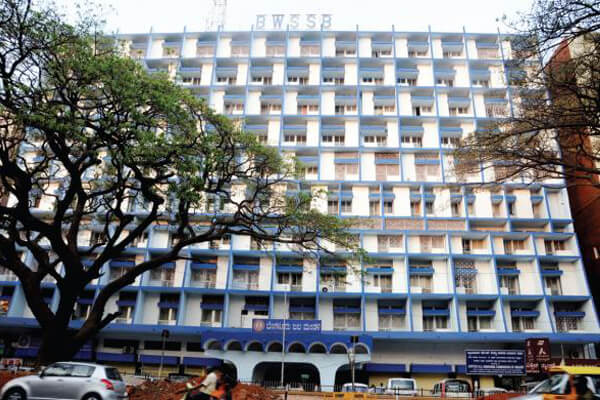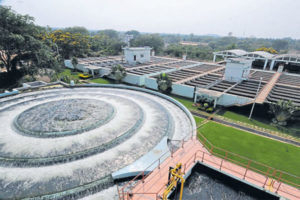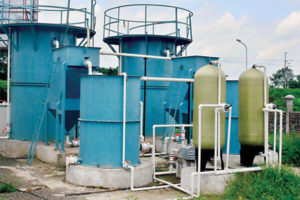
“Water conservation measures have to be done by the consumers. BWSSB had advocated measures to reduce usage of fresh water, rainwater harvesting both for recharging the groundwater and also for reuse in the households,” says Tushar Giri Nath, Chairman,Bangalore Water Supply And Sewerage Board (BWSSB) in an exclusive interview with Krishna Chandra Mishra of Elets News Network (ENN).
BWSSB has been one of the oldest utilities in the water and sanitation sector in India. What are the major challenges faced by BWSSB?
The major challenge so far has been the rapid pace of urbanisation since 1995. Over the last 25 years, there has been a massive surge in population owing to migration. To provide water to the city dwellers is a challenge since the city is not located at a riverhead. Similarly, the sewage generated is also to be taken care of. Owing to the distance from the river, we need to ensure that sewage generated doesn’t affect our lakes or other water bodies. Bengaluru has a unique setting in the Deccan Plateau, away from the river but has a series of lakes surrounding the city. If the sewage or solid waste is not treated properly at the source, it would find its way to the lakes, disrupting the ecology.

What are some of the water conservation measures that the board has undertaken?
Water conservation measures have to be undertaken by consumers. BWSSB had advocated measures to reduce the usage of freshwater, rainwater harvesting both for recharging the groundwater and also for reuse in the households. We had done the regulation in 2008 wherein all old houses, which are on 40*60 feet and new constructions in 30 *40 feet sites, have to compulsorily do the rainwater harvesting. At that time, our major thrust was to ensure that the groundwater depletion is mitigated, by allowing the rainwater to go to the ground. However, now we have changed our orientation and our focus is on the reuse of water and fresh regulations propose storage and reuse of water harvested from structures on a site bigger than 60*40 feet.

We had also given a push to the usage of treated water in the apartments and commercial complexes by asking and mandating them to have their own Sewage Treatment Plant (STP) and use it through a dual piping system in the apartment complexes and various units.
Further, we try to sell the treated water to the industries.
We have also mandated utilities such as Bruhat Bengaluru Mahanagara Palike (BBMP) to use treated water for purposes like watering the gardens etc. The major landmarks of the city– Cubbon Park, Lal Bagh, Raj Bhavan, Race Course, Golf Club, etc, are using the treated water. We are gradually implementing and popularising the concept of using treated water. However, it will still take some time to create awareness among people. Although STPs are being installed by private players, treatment of water is not on par with the standards prescribed by the Karnataka State Pollution Control Board (KSPCB). We want to bring a market for the private STP water to be sold for construction or any other commercial purposes and also to be used in the neigbourhood by mandating compulsory use of water in all households.
Smaller households can purchase treated water from the nearby apartments and use it for various purposes. KSPCB is in process of bringing out a portal that would enable online trading of secondary treated water and we are also partnering with them.
Building licenses and No Objection Certificates (NoCs) are being issued by collecting charges for treated water to be used during construction of projects. The market is gradually developing a water tanker for treated water.
What are the technological or digital innovations you are bringing in?
We had introduced Sakala programme to provide services like submitting application for connection, registering complaints, grievance redressal, etc. But it was a manual process and was not being tracked properly. Hence we developed online software and we have made it functional from 2017 for giving connections and related services. Now we are gradually becoming paperless in our operations and functioning. The process is also automated.
We have a 24*7 call centre and customer assistance and update service through calls and SMS. For the last seven to eight years, our billing system has become digitalised. We are also monitoring and operating our water reservoirs and chlorinators online.
We bring water from Kaveri River in three stages. The pumping is around 450 metres height. It is a very high energyconsuming process and for this, we have enabled electronic monitoring processes and assess the amount of water pumped and used across the state. To make the distribution system smart. We are yet to automate this process. Although we had introduced smart meters, it was discontinued owing to certain challenges. Once we work out these issues, we will enable the smart metering process again.
What is the scenario of the STPs? What are the challenges faced by the board regarding this and how are you tackling those?
 As per our estimation, around 1,450 MLD sewage is generated in the city, which is limited to the 575 sq. km. out of 800 sq. km. BBMP area. By 2017, we had 721 MLD capacity and now our capacity is 1,057 MLD. By July 2020, we are expecting to add 525 MLD of severage treatment capacity, which will make the estimated treatment capacity as 1,572 MLD. This is excluding the private sector STPs. Any apartment having more than 20 units or 2,000 sq. metre construction needs to have STPs within their premises. We have made stringent STP norms.
As per our estimation, around 1,450 MLD sewage is generated in the city, which is limited to the 575 sq. km. out of 800 sq. km. BBMP area. By 2017, we had 721 MLD capacity and now our capacity is 1,057 MLD. By July 2020, we are expecting to add 525 MLD of severage treatment capacity, which will make the estimated treatment capacity as 1,572 MLD. This is excluding the private sector STPs. Any apartment having more than 20 units or 2,000 sq. metre construction needs to have STPs within their premises. We have made stringent STP norms.
Kaveri Stage 5 is our major project which is going to bring additional 10 TMC feet water per year, which is equivalent to 775 MLD of water. Right now we are supplying 1,450 MLD of water. This will create more sewage. Hence we have to bring in more STPs to treat sewage. Although according to me, the STP structure of the state is balanced, we may have to take up the upgradation of STPs by 2023.
Also Read: Karnataka Moving towards an Inclusive Healthcare
Over the years, we have tried to bring in a closed pipe network across the city to avoid the percolation of sewage in the water supplies.
What is the opportunity for private investors in this sector of Karnataka? Are any publicprivate projects in progress?
At the moment, there are no PPP projects; however, there is an opportunity to explore it in a couple of areas. Right now, the biggest opportunity of PPP model projects is in energy-saving of our old pumping stations. There is huge expenditure involved with the threestage pumping process. There is scope in taking up projects which would reduce the energy consumption and that can be on a PPP mode. However, there is a concern about how much energy would be saved. If we are very conservative about estimating the energy, it will give undue advantage to the investor. That is why our Finance department was not very keen on taking this up. Hence, this is still under consideration.
 Another opportunity is in power generation through sludge. A huge amount of bio-solids is being generated everyday across the city. The cumulative capacity is 458 MLD, which is not properly utilised. At present, only one power plant of 1.5 Mega Watt (MW) capacity is operating. We have asked the new STPs to install power plants. For the old STPs, we are planning for a system of integrated sludge management including power generation and conversion of the type of sludge from C Class to A Class, as C Class sludge contains bacteria, hence it cannot be utilised as a fertilizer directly. Once this is done, we can also plan marketing the fertilizer generated from the sludge.
Another opportunity is in power generation through sludge. A huge amount of bio-solids is being generated everyday across the city. The cumulative capacity is 458 MLD, which is not properly utilised. At present, only one power plant of 1.5 Mega Watt (MW) capacity is operating. We have asked the new STPs to install power plants. For the old STPs, we are planning for a system of integrated sludge management including power generation and conversion of the type of sludge from C Class to A Class, as C Class sludge contains bacteria, hence it cannot be utilised as a fertilizer directly. Once this is done, we can also plan marketing the fertilizer generated from the sludge.
Another aspect which we are contemplating is charging for the per MLD cost for bringing the old STPs for treatment of the sewage, which is yet to be upgraded. This is termed as technology-neutral bidding. The bidding of the treated sewage or sludge can be done, provided it meets the standard of the bidders.
What is your vision for the Board for the upcoming years?
As far as our service is concerned, we have to reduce unaccounted water usage. The energy extensive pumping is leading to increased expenditure. We are also working towards making water more affordable for our consumers. While some aspects like manpower cost, treatment cost etc. The factors in which we can control the cost are plugging of leakages etc. Right now we are at 35 percent of Unaccounted-for Water (UFW). We believe that a physical part would be 15 to 20 percent. Around 15 percent of the consumers are not paying the water charges and we would penalise them. Also, to curb the physical losses, we are taking measures such as repairing the old pipelines. We are also the first utility that has gone for the District Metered Areas (DMA) approach. Here we take the watered network and break it down to the smallest cell where we know about the number of inlets and outlets, consumption patterns and leakage. We have to audit the water loss and reduce it. We have taken up a large number of projects, amounting to approximately Rs 650 crore. Other than that, we replace the old lines with new lines regularly. We have invested around Rs 1,000 crore in auditing intending to reduce unaccounted water usage.
Also Read: Karnataka ensuring smart energy for all
Our major concern is to see that quality water is distributed at the optimal cost while improving efficiency. We also aim to reduce the inefficiency on the board’s part in terms of distribution network as well as the manpower and see that all the sewage generated in the city is captured and transferred to the STP and treated properly, as per the prescribed effluent parameters and treat the sludge as a resource and not as waste. We also need to open new avenues of revenue by exploring each possible opportunity.
Also Read: Karnataka has taken lead in urban mobility: Ramandeep Chowdhary
Be a part of Elets Collaborative Initiatives. Join Us for Upcoming Events and explore business opportunities. Like us on Facebook , connect with us on LinkedIn and follow us on Twitter, Instagram.











